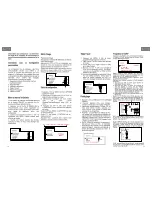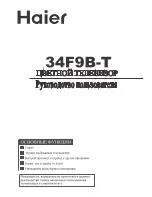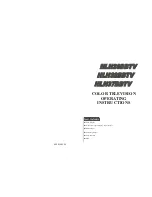
CIRCUIT OVERVIEW
3828VD0171G
3-2
DIGITAL FCS - CIRCUIT OVERVIEW
When QX3204 is turned off some of this
energy is returned to charge the S-
capacitor(s) CX3209, CX3208, and CX3210.
After several cycles (repeating at scan-
ning frequency) sufficient voltage ap-
pears across the S-capacitor providing
an additional path producing current
flow though the horizontal deflection
yoke coil (connector CN3Y3). The Damper
Diodes DX3202 and DX3203 provide the
negative current path. The result is a
positive and negative saw tooth cur-
rent through the horizontal deflection
coils (approximately 12 to 14 Amps.
peak to peak). When QX3204 is turned
off about 1300 Volts peak of flyback
voltage is produced from the stored
energy in the horizontal deflection
coils and TX3201. This voltage is in-
duced to secondary windings of TX3201
to generate the high voltage, 30 KV.
The flyback (or retrace) period is about
5 uS.
A capacitive divider, CX3205 and CX3207,
provides a low voltage flyback pulse
(H-FBP) used for synchronization, phase
comparison, etc. This pulse is sent to
the main chassis via pin 3 of connector
CN1D2. Linearity Coil, L3200, is a satu-
rating inductor skewed by a permanent
magnet bonded to the coil. It produces
a nonlinear inductance curve vs the
current. This characteristic cancels
non-linearities in the deflection cur-
rent caused by horizontal deflection
coil resistance.
Base Drive
The base Drive circuit provides high
forward and reverse current to drive
the base of the Horizontal Output Tran-
sistor QX3204, from a low level input
(H-DRV from the Deflection Processor,
ICM2200, in Main Chassis) at pin 2 of
connector CN1D2. This signal is ap-
proximately 9 volts peak at the oper-
ating frequency and has a duty cycle of
about 40% high, 60% low.
Current from H-DRV is amplified by tran-
sistor Q3200 and Q3201, providing a
low impedance to rapidly drive the gate
of the drive transistor, Q3203. This
action results in an alternating cur-
rent flow in the primary of driver trans-
former, TX3200. During Q3203 on time,
energy is stored in TX3200 and rapid
turn off of QX3204 is initiated. Dur-
ing Q3203 off time, the energy previ-
ously stored in TX3200 is used to drive
the base of QX3204.
Pincushion Modulator Circuit
This circuit receives a pincushion and
size correction signal. EW-DRV from the
Deflection Processor (ICM2200), Pin 4
of connector CN1D2, modulates the Yoke
current to provide keystone and pin-
cushion geometric correction. EW-DRV
is a vertical deflection rate parabola.
Shutdown Circuit
The flyback pulse voltage from pin 9 of
TX3201 (Flyback Transformer) is peak
detected (rectified) by the action of
diode D3205 and capacitor C3218. This
form a DC voltage appearing on C3218
representative of the CRT anode volt-
age (HV) produced by TX3201. Precision
resistors R3001, R3002, R3003 and R3004
divide this voltage down. This lower
voltage appears on one input of the
comparator circuit formed by Q3000 and
ZD3003. In the event the CRT anode volt-
age become excessive, the comparator
circuit output will go to high level at
approximately 5 volts. This signal (H-
PROT) is send to Deflection Processor
(ICM2200), Pin 7 of connector CN1D2,
causing Horizontal Drive to be dis-
abled and latched, preventing further
generation of anode voltage. The drive
will remain off until power (via re-
mote control or front panel) is cycled
from “Off” to “On”.
Vertical Deflection
The Vertical Deflection circuit, IC2100,
is a linear amplifier that can directly
drive the yoke current (including the
required DC component). The sawtooh
waveforms needed, as inputs, by IC2100
are generated in the Deflection Pro-
cessor, ICM2200, in Main Chassis, VD+
and VD- pin 11 and 22 of connector
CN1D2.
















































